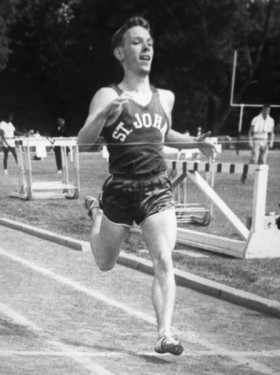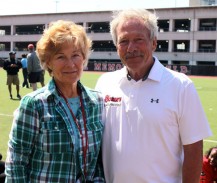
Forty-seven years ago, American runner Tommie Smith took the gold medal stand after setting a new world record in the 200-meter race at the 1968 Mexico City Olympics.
He was joined by his teammate, John Carlos, who finished in third place.
Though this set-up seems like any typical occurrence on an Olympic podium, this particular medal ceremony soon became memorable.
Wearing black socks, scarves, necklaces and one black glove each during the playing of the national anthem, Smith and Carlos bowed their heads and raised a fist to give the “Black Power” salute – a gesture signifying the inequalities faced by blacks during the Civil Rights Movement.
As this was going on, standing in the front row was Tom Farrell, a product of Our Lady Queen of Martyrs parish, Forest Hills. He was a teammate of Smith and Carlos who was competing in his second Olympic Games.
The journey for Farrell to arrive at that moment began at Archbishop Molloy H.S., Briarwood, when he joined the school’s track team as a freshman in 1957. He eventually earned a track scholarship to St. John’s University, Jamaica.
After becoming St. John’s first-ever NCAA champion as a junior in college, Farrell qualified for the 1964 Tokyo Olympics, where he finished in fifth place in the 800-meter run.
“I still pinch myself that it happened,” said Farrell, who also was a 1965 NCAA champion en route to becoming one of the most decorated athletes in St. John’s history. “It was awesome to not only represent the country but you represent people you went to high school with, represent St. John’s, your parents, your family. It was just awesome to be part of the Olympic team.”
After graduating from St. John’s in 1966 and joining the U.S. Army, Farrell again qualified for the Olympics in 1968. This time around, he won the bronze medal in the 800-meter run.
In the months leading up to the Olympics, he developed friendships with Smith and Carlos, especially since Carlos was also originally from New York City. At the time, there were discussions, led by Dr. Harry Edwards from UCLA, that black athletes should boycott the Olympics to protest the societal injustices they faced.
But rather than boycott a once-in-a-lifetime opportunity, Smith and Carlos had a different plan. And right when they crossed the finish line on Oct. 16, 1968, Farrell knew he needed a front-row seat.
For their actions in giving the “Black Power” salute, Smith and Carlos were booed vehemently by the crowd as they left podium. Additionally, International Olympic Committee President Avery Brundage suspended the two athletes for the rest of the games and banned them from the Olympic Village.
The image became front-page news around the globe, and Smith and Carlos received heavy criticism, including death threats to their families. However, as is the definition of a team, Farrell and the other U.S. track Olympians supported their teammates.

“We were part of a team,” he said. “We all loved each other. We were all friends. There were no problems among any team members. We supported what they thought was right.”
Years later, the iconic Olympic moment is remembered as a powerful stand taken by two athletes who firmly believed in their cause – no matter the consequences.
“What they did was a tremendously patriotic statement that they were sincere about,” Farrell said. “It demonstrated what they felt was right because of all the injustices that blacks had undertaken through so many years. You look back many years later, and these guys are heroes for what they did.”
These days, Farrell, who was a member of the St. John’s inaugural Hall of Fame class, splits his time between New York and Los Angeles. For the past 15 years, he has served as a volunteer assistant track coach at his alma mater, serving as a mentor to the runners. The track team hosts a track meet in his honor, the Tom Farrell Classic, each spring.
“St. John’s has a fondness,” he said. “I love the school; I love the kids. The school has been very good to me. It was my way of giving back.”
Every once in a while, Farrell will run into Smith or Carlos to relive those Olympic memories. And in the true spirit of team, he has always stood by his teammates’ iconic gesture.
“They’re my brothers,” he said. “They sure are!”
Contact Jim Mancari via email at jmmanc@gmail.com.

What these guys did was wrong. It was the wrong time wrong time and unpatriotic. They are not heroes .
No,in my opinion, definitely not wrong. It was a courageous and thoughtful and non violent action drawing attention to a blight upon the American experience. Tom Farrell was right in his assessment then, and now. Carlos and Smith deserve recognition and respect for drawing the national attention to the issue.
A few short years later, many of us Caucasian Americans could recount, with appreciation and pride of brotherhood,, the dedicated service so many Americans of black ancestry and heritage, brought to the forces serving, and in many cases, dying for American military actions in SVN,,,,,nothing new there, black Americans have been paying into the American system with blood, from Bunker Hill, through Civil War, WWI and II battlefields and more. It was entirely appropriate to get the attention of America to its problems.
Tommie Smith and John Carlos never meant to be heroes with their Olympic podium statement…instead, they represented their country, our country to their fullest potential in spite of being treated as second class citizens and then, when given an opportunity to speak, did so with a vivid but silent gesture…a gesture meant to remind the world that racial inequities were STILL
a prominent part of the fabric of America… no heroics, just an ‘uncomfortable reminder’ .
Michael J. Fanelli
former coach Team USA
There are a lot of definitions of heroism, and the word seems to a bit overused in the media of late. But, there’s no doubt that what Tommie Smith and John Carlos did on that Olympic medal podium in 1968 took a lot of courage. They knew that the vindictive Avery Brundage and the highly conservative USOC hierarchy would punish them heavily (not just at the ’68 Olympics, but, for years afterward) for standing up for all African-Americans and calling attention to the violations of civil and human rights that continue to this very day. I’m a few years younger than Tom Farrell, but, I was a collegiate runner in ’68, and I never heard anyone in the track & field community express anything but admiration and support for Smith and Carlos. All these years later, I’m glad to see that Tom Farrel continues to be an exemplar of the spirit and solidarity of that community.
My season has so far been awesome, no complaints whatsoever,